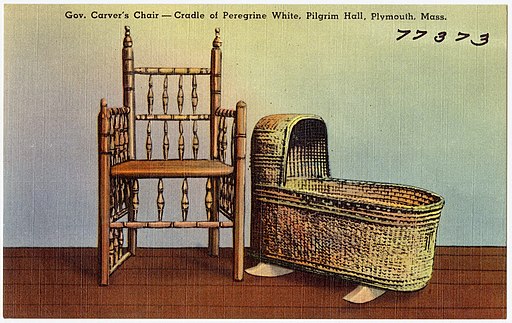Have you been following our Fun Facts series? We started last week looking at a special spin off of "Who was at the first Thanksgiving?" Be sure to check out our Fun Facts about William Bradford, Squanto, and John Billington and Family (coming soon). Today we are sharing our fun facts about Edward Winslow.
- Edward Winslow was born on October 18, 1595, at Droitwich, Worcester, England. He was the son of Edward and Magdalene (Oliver) Winslow. He was baptized on October 20, 1595, at St. Peter’s in Droitwich. He was educated in an Anglican cathedral school and attended university in Cambridge. He also was an apprentice printer in London, but left before he completed his training.
- He moved to Holland in 1617 where he united with John Robinson’s Separatist church. He married Elizabeth Barker on May 16, 1618, in Leiden, Holland.
- Edward Winslow is the only original settler whose portrait is still around.
- His wife, Elizabeth, died in March 1621, the first winter in Plymouth.
- Almost everything we know about the first Thanksgiving is due to a few lines in a letter written by Edward Winslow.
- Edward Winslow crossed the river to talk to Massasoit. He wore a full suit of armor and carried his sword. The chief offered to buy them since he liked them so much. He brought gifts with him to meet the Native Americans.
- When he met Massasoit or Ousamequin (Yellow Feather) Edward Winslow bowed and gave him a chain with a jewel in it, knives, butter and a pot of brandy. He told him King James of England saluted him in words of love and peace and hoped he would be his friend. He also told Massasoit that the governor of Plymouth Colony wanted to meet him, trade with him and make peace with him. Of course all communication was done with Squanto translating.
- Massasoit agreed to go to Plymouth to meet with Governor Carver if Edward Winslow stayed behind as a hostage. Massasoit took twenty Native Americans with him.
- On May 12, 1621, Edward Winslow married Susanna White. (Susanna gave birth to Peregrine White on the Mayflower when it was docked in Provincetown.) This was the first marriage in Plymouth Colony. Susanna White was a widow. They had five children. One died young prior to being named. The others were Edward, John, Josiah and Elizabeth.
- Edward Winslow and Stephen Hopkins were sent to Massasoit to discuss the problem of native Americans stopping by Plymouth Colony in large numbers and needing to be fed. The colonists worried about not having enough food for the winter. Edward Winslow left a copper chain with Massasoit to have a special messenger wear into Plymouth so they would know Massasoit sent him.
- When Massasoit was seriously ill, Edward Winslow walked to his village and personally nursed him back to health with soup. (I have read it was chicken soup and duck soup and herbs.)
- He wrote several first-hand accounts of the early years. He also became involved in defending Plymouth and Massachusetts Bay Colonies to opponents and adversaries in England and traveled back and forth several times. His first trip back was in 1624.
- He held a number of political offices including being elected assistant governor several times. He was elected governor of Plymouth on three occasions 1633-34, 1636-37, and 1644-45. He left Massachusetts Bay Colony in October 1645 and did not return.
- He died on May 8, 1655 at sea between Hispaniola and Jamaica. He was serving as a commissioner for Oliver Cromwell on a military expedition.
- Edward Winslow was described as an energetic and strong person. His strength and fortitude in dealing with multiple challenges facing Plymouth Colony and later New England.
 |
| Portrait of Edward Winslow |
 |
| Massasoit Statue in Kansas City, MO https://commons.wikimedia.org/wiki/File:Massasoit,_KC_MO_-_detail.JPG |
 |
| Governor John Carver's Chair and Peregrine White's Cradle By Pub. by Smith's Inc., Plymouth, Mass. Tichnor Bros. Inc., Boston, Mass. [Public domain], via Wikimedia Commons |
Sources:
- Editors of Encyclopedia Britainica. Edward Winslow. (7/20/98) https://www.britannica.com/biography/Edward-Winslow
- Hanc, John. The Plymouth Hero You Should Really Be Thankful for This Thanksgiving. (11/21/16) https://www.smithsonianmag.com/history/why-edward-winslow-plymouth-hero-thanksgiving-180961174/
- Johnson, Caleb. Edward Winslow. http://mayflowerhistory.com/winslow-edwar/
- Recht Penner, Lucille. The Pilgrims at Plymouth. (1996) Random House. New York.

